BUSS 2068 Case Study: Evaluating Jeff Bezos' Leadership at Amazon
VerifiedAdded on 2023/06/11
|11
|2679
|287
Case Study
AI Summary
This case study examines Jeff Bezos' leadership style at Amazon, analyzing its impact on the company's success, employee motivation, and ethical considerations. Bezos' leadership is characterized as a mix of transactional and transformational styles, emphasizing customer satisfaction and long-term growth. The report delves into how Bezos' approach affects employee motivation, referencing theories like Maslow's Hierarchy of Needs and the Motivation-Hygiene Theory. It also explores the ethical dimensions of his leadership, addressing concerns about work pressure and authoritarian tendencies while acknowledging his encouragement of self-direction and innovation. The study concludes that while Bezos' leadership has propelled Amazon to the forefront of the e-commerce industry, it also presents challenges regarding employee well-being and ethical practices. Desklib provides access to similar case studies and resources for students.
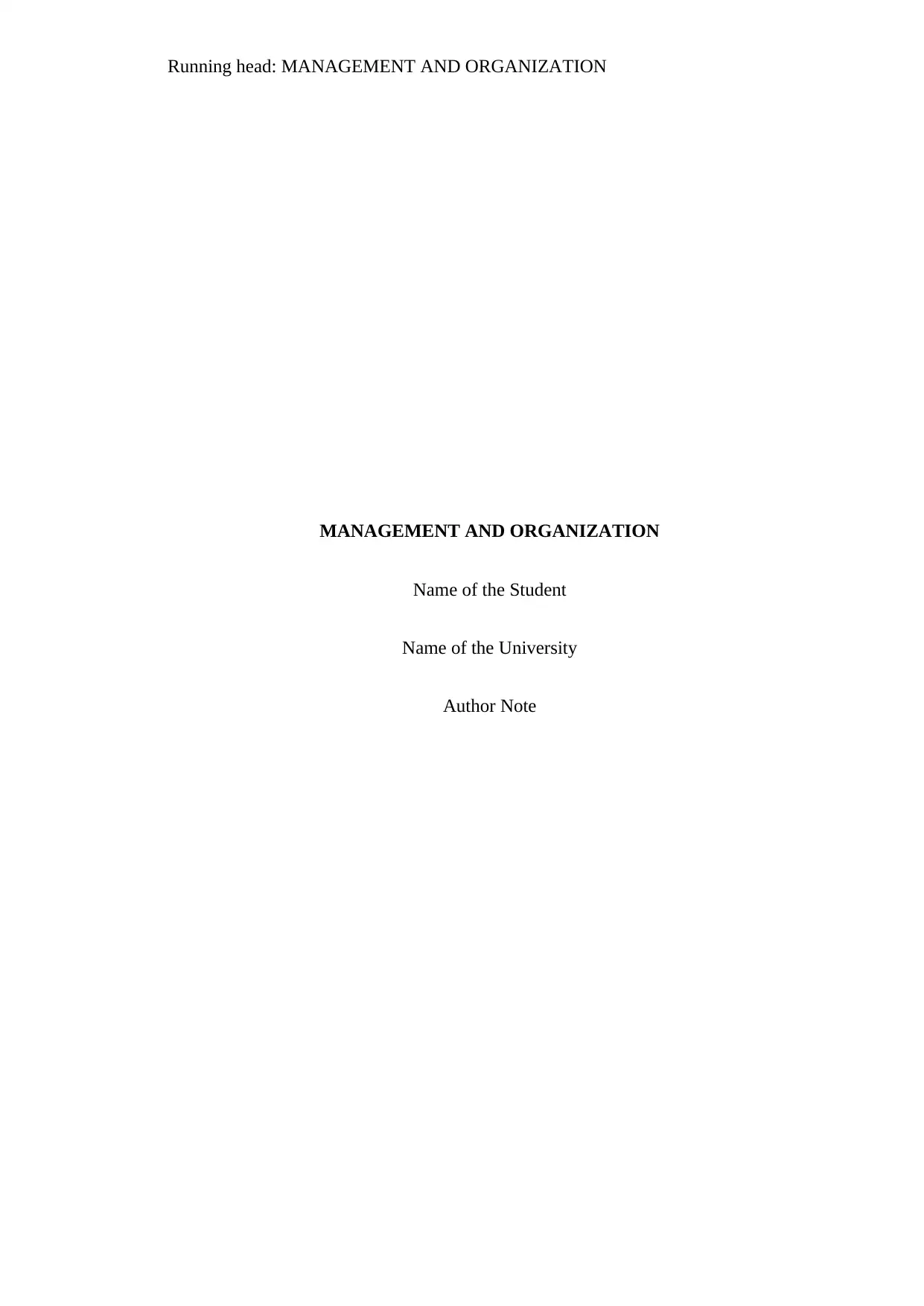
Running head: MANAGEMENT AND ORGANIZATION
MANAGEMENT AND ORGANIZATION
Name of the Student
Name of the University
Author Note
MANAGEMENT AND ORGANIZATION
Name of the Student
Name of the University
Author Note
Paraphrase This Document
Need a fresh take? Get an instant paraphrase of this document with our AI Paraphraser
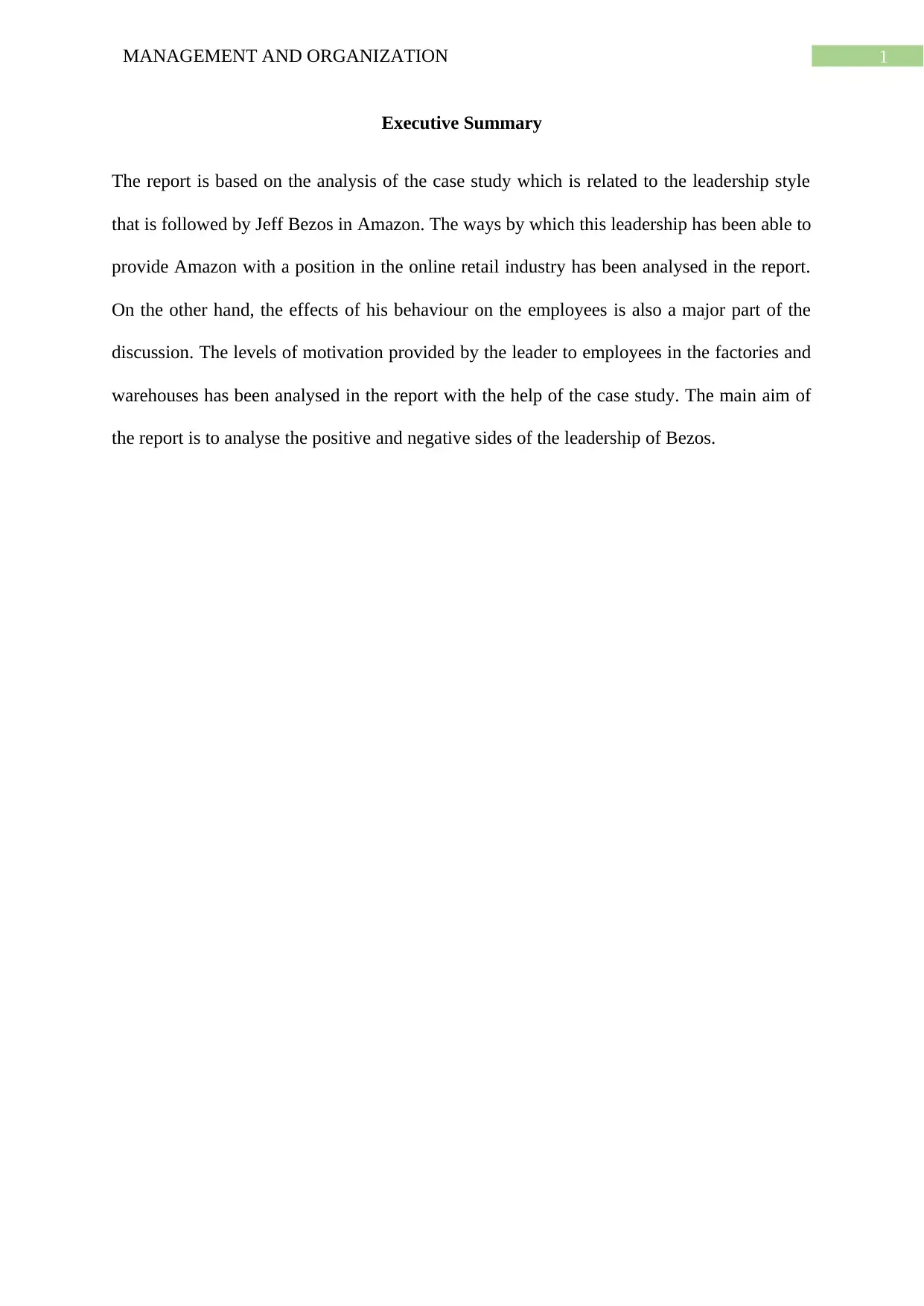
1MANAGEMENT AND ORGANIZATION
Executive Summary
The report is based on the analysis of the case study which is related to the leadership style
that is followed by Jeff Bezos in Amazon. The ways by which this leadership has been able to
provide Amazon with a position in the online retail industry has been analysed in the report.
On the other hand, the effects of his behaviour on the employees is also a major part of the
discussion. The levels of motivation provided by the leader to employees in the factories and
warehouses has been analysed in the report with the help of the case study. The main aim of
the report is to analyse the positive and negative sides of the leadership of Bezos.
Executive Summary
The report is based on the analysis of the case study which is related to the leadership style
that is followed by Jeff Bezos in Amazon. The ways by which this leadership has been able to
provide Amazon with a position in the online retail industry has been analysed in the report.
On the other hand, the effects of his behaviour on the employees is also a major part of the
discussion. The levels of motivation provided by the leader to employees in the factories and
warehouses has been analysed in the report with the help of the case study. The main aim of
the report is to analyse the positive and negative sides of the leadership of Bezos.
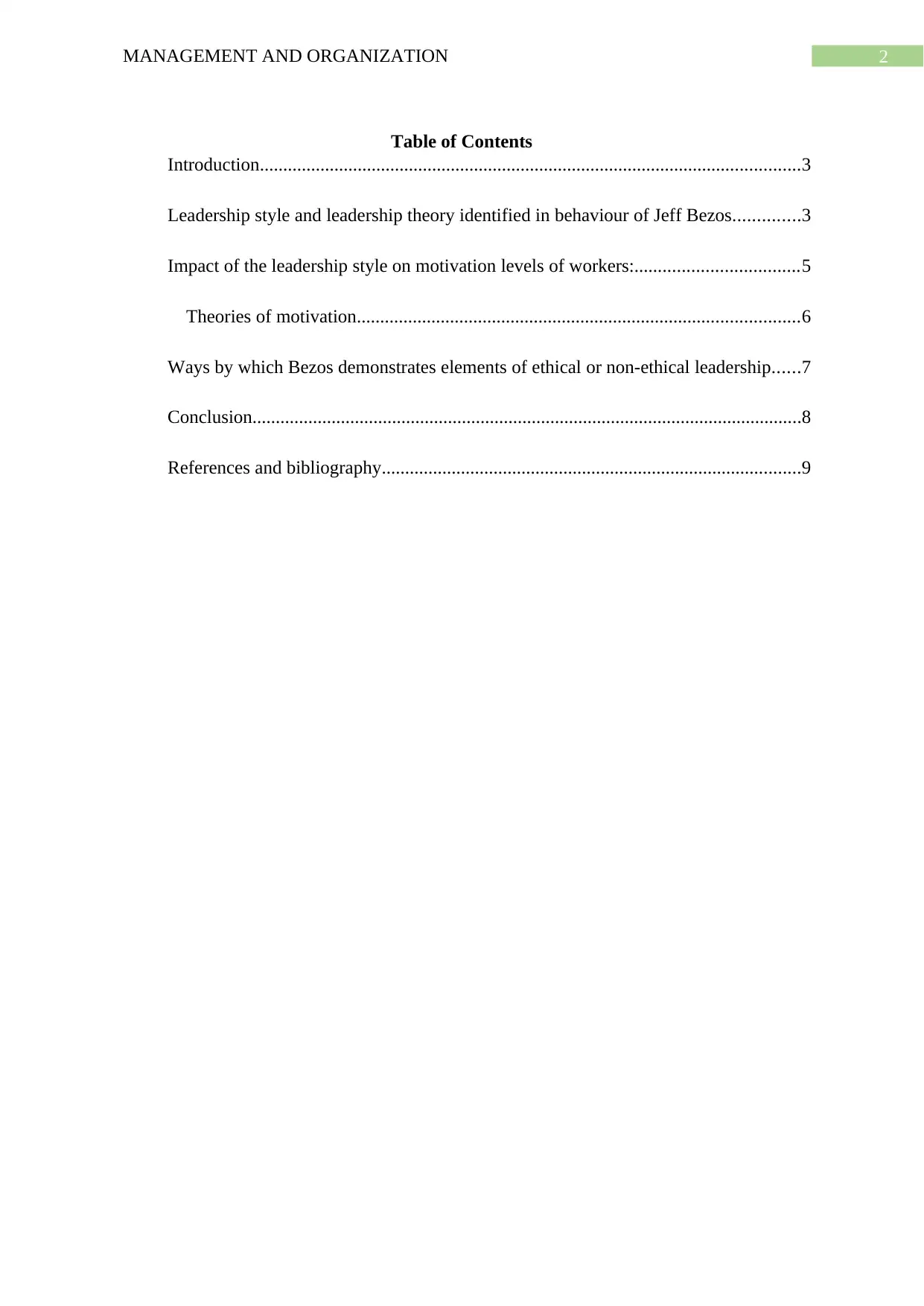
2MANAGEMENT AND ORGANIZATION
Table of Contents
Introduction....................................................................................................................3
Leadership style and leadership theory identified in behaviour of Jeff Bezos..............3
Impact of the leadership style on motivation levels of workers:...................................5
Theories of motivation...............................................................................................6
Ways by which Bezos demonstrates elements of ethical or non-ethical leadership......7
Conclusion......................................................................................................................8
References and bibliography..........................................................................................9
Table of Contents
Introduction....................................................................................................................3
Leadership style and leadership theory identified in behaviour of Jeff Bezos..............3
Impact of the leadership style on motivation levels of workers:...................................5
Theories of motivation...............................................................................................6
Ways by which Bezos demonstrates elements of ethical or non-ethical leadership......7
Conclusion......................................................................................................................8
References and bibliography..........................................................................................9
⊘ This is a preview!⊘
Do you want full access?
Subscribe today to unlock all pages.

Trusted by 1+ million students worldwide
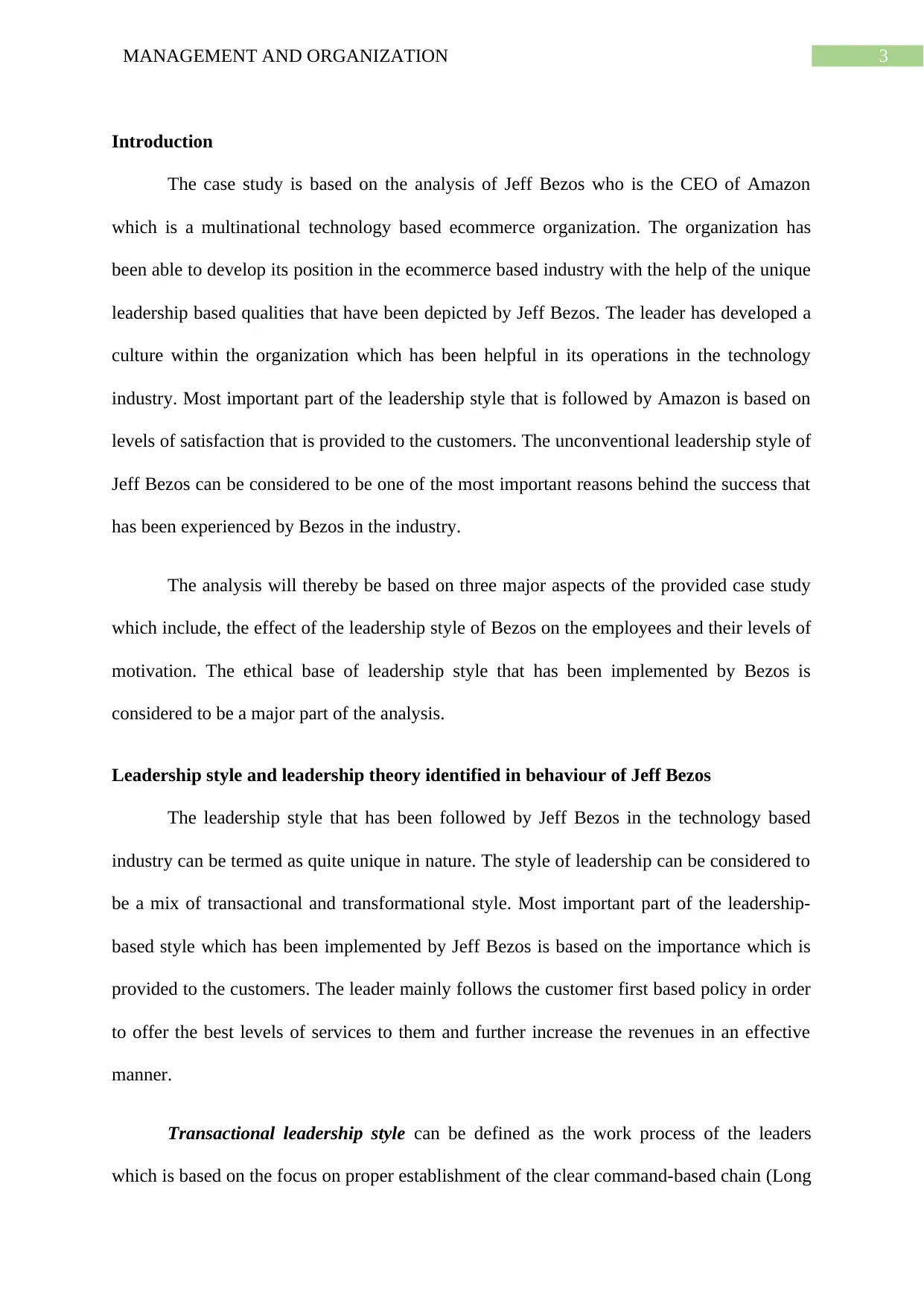
3MANAGEMENT AND ORGANIZATION
Introduction
The case study is based on the analysis of Jeff Bezos who is the CEO of Amazon
which is a multinational technology based ecommerce organization. The organization has
been able to develop its position in the ecommerce based industry with the help of the unique
leadership based qualities that have been depicted by Jeff Bezos. The leader has developed a
culture within the organization which has been helpful in its operations in the technology
industry. Most important part of the leadership style that is followed by Amazon is based on
levels of satisfaction that is provided to the customers. The unconventional leadership style of
Jeff Bezos can be considered to be one of the most important reasons behind the success that
has been experienced by Bezos in the industry.
The analysis will thereby be based on three major aspects of the provided case study
which include, the effect of the leadership style of Bezos on the employees and their levels of
motivation. The ethical base of leadership style that has been implemented by Bezos is
considered to be a major part of the analysis.
Leadership style and leadership theory identified in behaviour of Jeff Bezos
The leadership style that has been followed by Jeff Bezos in the technology based
industry can be termed as quite unique in nature. The style of leadership can be considered to
be a mix of transactional and transformational style. Most important part of the leadership-
based style which has been implemented by Jeff Bezos is based on the importance which is
provided to the customers. The leader mainly follows the customer first based policy in order
to offer the best levels of services to them and further increase the revenues in an effective
manner.
Transactional leadership style can be defined as the work process of the leaders
which is based on the focus on proper establishment of the clear command-based chain (Long
Introduction
The case study is based on the analysis of Jeff Bezos who is the CEO of Amazon
which is a multinational technology based ecommerce organization. The organization has
been able to develop its position in the ecommerce based industry with the help of the unique
leadership based qualities that have been depicted by Jeff Bezos. The leader has developed a
culture within the organization which has been helpful in its operations in the technology
industry. Most important part of the leadership style that is followed by Amazon is based on
levels of satisfaction that is provided to the customers. The unconventional leadership style of
Jeff Bezos can be considered to be one of the most important reasons behind the success that
has been experienced by Bezos in the industry.
The analysis will thereby be based on three major aspects of the provided case study
which include, the effect of the leadership style of Bezos on the employees and their levels of
motivation. The ethical base of leadership style that has been implemented by Bezos is
considered to be a major part of the analysis.
Leadership style and leadership theory identified in behaviour of Jeff Bezos
The leadership style that has been followed by Jeff Bezos in the technology based
industry can be termed as quite unique in nature. The style of leadership can be considered to
be a mix of transactional and transformational style. Most important part of the leadership-
based style which has been implemented by Jeff Bezos is based on the importance which is
provided to the customers. The leader mainly follows the customer first based policy in order
to offer the best levels of services to them and further increase the revenues in an effective
manner.
Transactional leadership style can be defined as the work process of the leaders
which is based on the focus on proper establishment of the clear command-based chain (Long
Paraphrase This Document
Need a fresh take? Get an instant paraphrase of this document with our AI Paraphraser
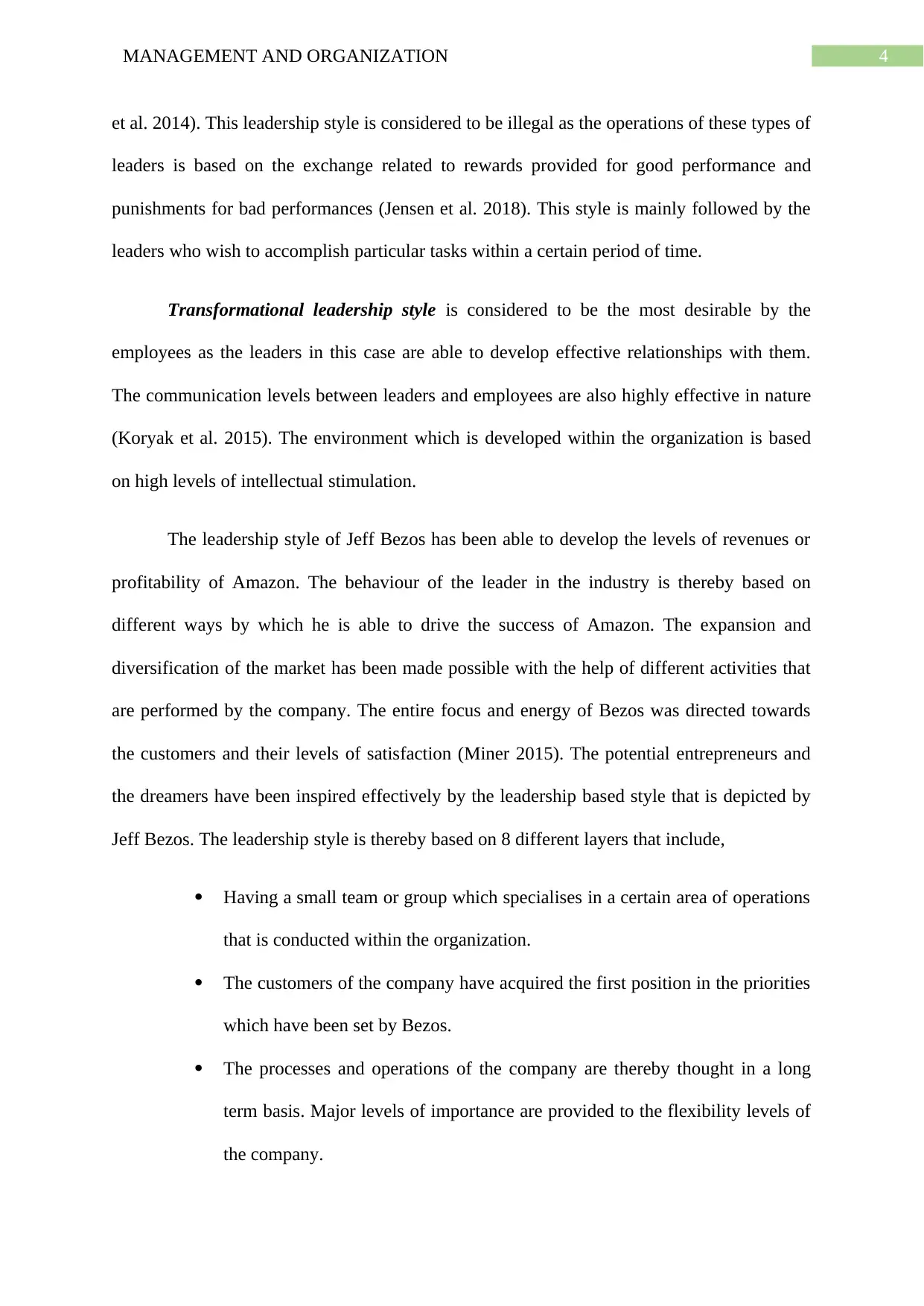
4MANAGEMENT AND ORGANIZATION
et al. 2014). This leadership style is considered to be illegal as the operations of these types of
leaders is based on the exchange related to rewards provided for good performance and
punishments for bad performances (Jensen et al. 2018). This style is mainly followed by the
leaders who wish to accomplish particular tasks within a certain period of time.
Transformational leadership style is considered to be the most desirable by the
employees as the leaders in this case are able to develop effective relationships with them.
The communication levels between leaders and employees are also highly effective in nature
(Koryak et al. 2015). The environment which is developed within the organization is based
on high levels of intellectual stimulation.
The leadership style of Jeff Bezos has been able to develop the levels of revenues or
profitability of Amazon. The behaviour of the leader in the industry is thereby based on
different ways by which he is able to drive the success of Amazon. The expansion and
diversification of the market has been made possible with the help of different activities that
are performed by the company. The entire focus and energy of Bezos was directed towards
the customers and their levels of satisfaction (Miner 2015). The potential entrepreneurs and
the dreamers have been inspired effectively by the leadership based style that is depicted by
Jeff Bezos. The leadership style is thereby based on 8 different layers that include,
Having a small team or group which specialises in a certain area of operations
that is conducted within the organization.
The customers of the company have acquired the first position in the priorities
which have been set by Bezos.
The processes and operations of the company are thereby thought in a long
term basis. Major levels of importance are provided to the flexibility levels of
the company.
et al. 2014). This leadership style is considered to be illegal as the operations of these types of
leaders is based on the exchange related to rewards provided for good performance and
punishments for bad performances (Jensen et al. 2018). This style is mainly followed by the
leaders who wish to accomplish particular tasks within a certain period of time.
Transformational leadership style is considered to be the most desirable by the
employees as the leaders in this case are able to develop effective relationships with them.
The communication levels between leaders and employees are also highly effective in nature
(Koryak et al. 2015). The environment which is developed within the organization is based
on high levels of intellectual stimulation.
The leadership style of Jeff Bezos has been able to develop the levels of revenues or
profitability of Amazon. The behaviour of the leader in the industry is thereby based on
different ways by which he is able to drive the success of Amazon. The expansion and
diversification of the market has been made possible with the help of different activities that
are performed by the company. The entire focus and energy of Bezos was directed towards
the customers and their levels of satisfaction (Miner 2015). The potential entrepreneurs and
the dreamers have been inspired effectively by the leadership based style that is depicted by
Jeff Bezos. The leadership style is thereby based on 8 different layers that include,
Having a small team or group which specialises in a certain area of operations
that is conducted within the organization.
The customers of the company have acquired the first position in the priorities
which have been set by Bezos.
The processes and operations of the company are thereby thought in a long
term basis. Major levels of importance are provided to the flexibility levels of
the company.
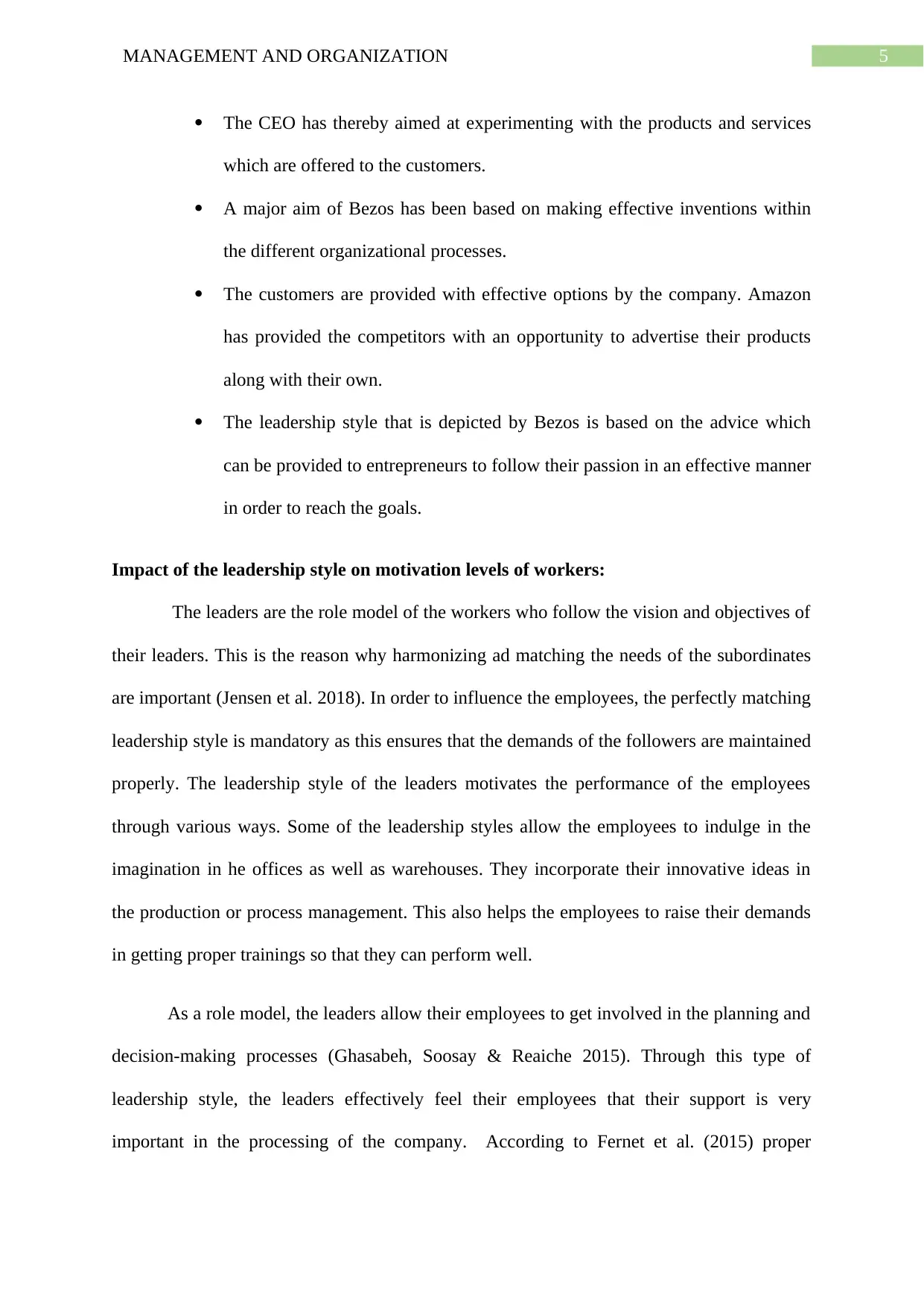
5MANAGEMENT AND ORGANIZATION
The CEO has thereby aimed at experimenting with the products and services
which are offered to the customers.
A major aim of Bezos has been based on making effective inventions within
the different organizational processes.
The customers are provided with effective options by the company. Amazon
has provided the competitors with an opportunity to advertise their products
along with their own.
The leadership style that is depicted by Bezos is based on the advice which
can be provided to entrepreneurs to follow their passion in an effective manner
in order to reach the goals.
Impact of the leadership style on motivation levels of workers:
The leaders are the role model of the workers who follow the vision and objectives of
their leaders. This is the reason why harmonizing ad matching the needs of the subordinates
are important (Jensen et al. 2018). In order to influence the employees, the perfectly matching
leadership style is mandatory as this ensures that the demands of the followers are maintained
properly. The leadership style of the leaders motivates the performance of the employees
through various ways. Some of the leadership styles allow the employees to indulge in the
imagination in he offices as well as warehouses. They incorporate their innovative ideas in
the production or process management. This also helps the employees to raise their demands
in getting proper trainings so that they can perform well.
As a role model, the leaders allow their employees to get involved in the planning and
decision-making processes (Ghasabeh, Soosay & Reaiche 2015). Through this type of
leadership style, the leaders effectively feel their employees that their support is very
important in the processing of the company. According to Fernet et al. (2015) proper
The CEO has thereby aimed at experimenting with the products and services
which are offered to the customers.
A major aim of Bezos has been based on making effective inventions within
the different organizational processes.
The customers are provided with effective options by the company. Amazon
has provided the competitors with an opportunity to advertise their products
along with their own.
The leadership style that is depicted by Bezos is based on the advice which
can be provided to entrepreneurs to follow their passion in an effective manner
in order to reach the goals.
Impact of the leadership style on motivation levels of workers:
The leaders are the role model of the workers who follow the vision and objectives of
their leaders. This is the reason why harmonizing ad matching the needs of the subordinates
are important (Jensen et al. 2018). In order to influence the employees, the perfectly matching
leadership style is mandatory as this ensures that the demands of the followers are maintained
properly. The leadership style of the leaders motivates the performance of the employees
through various ways. Some of the leadership styles allow the employees to indulge in the
imagination in he offices as well as warehouses. They incorporate their innovative ideas in
the production or process management. This also helps the employees to raise their demands
in getting proper trainings so that they can perform well.
As a role model, the leaders allow their employees to get involved in the planning and
decision-making processes (Ghasabeh, Soosay & Reaiche 2015). Through this type of
leadership style, the leaders effectively feel their employees that their support is very
important in the processing of the company. According to Fernet et al. (2015) proper
⊘ This is a preview!⊘
Do you want full access?
Subscribe today to unlock all pages.

Trusted by 1+ million students worldwide
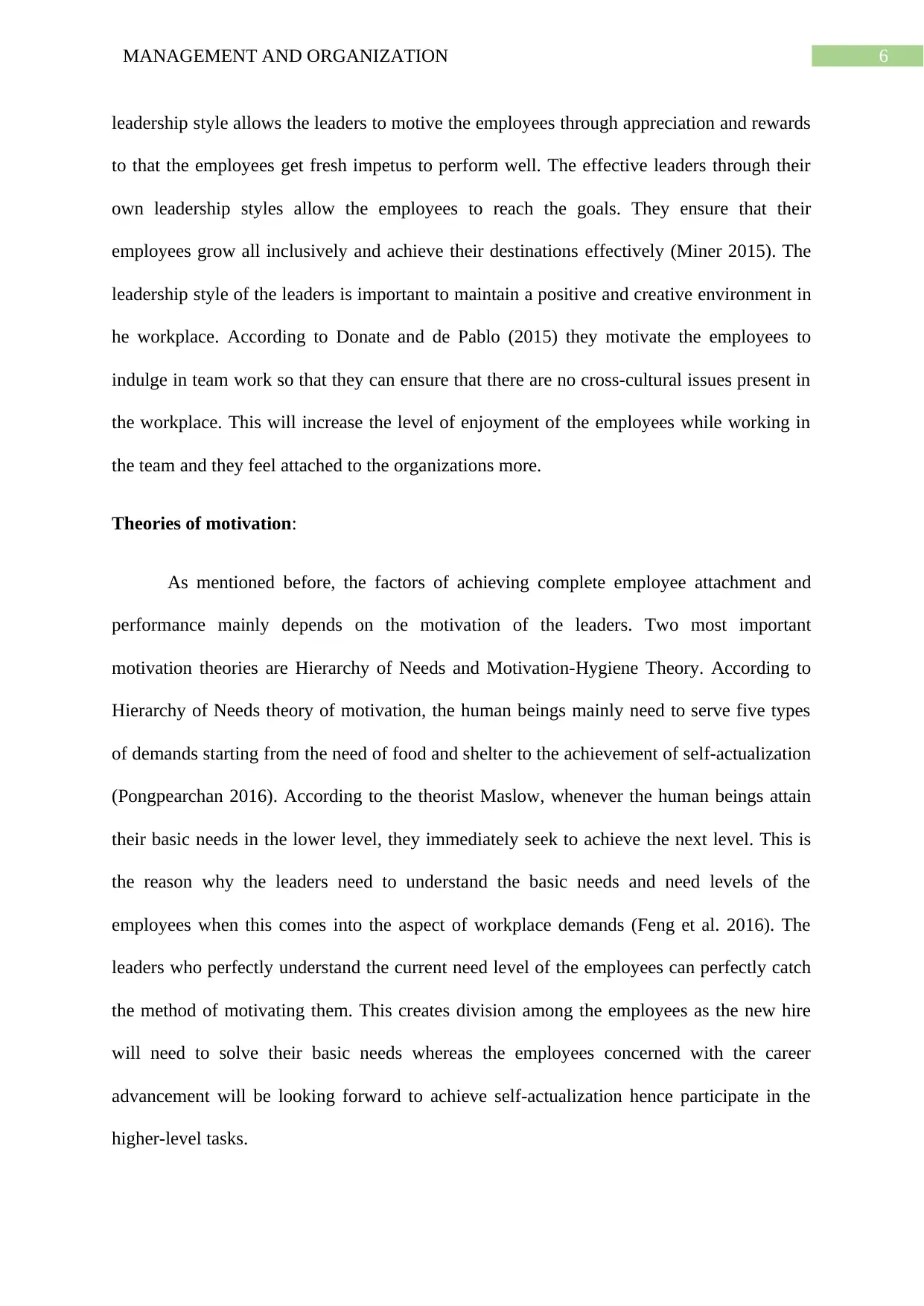
6MANAGEMENT AND ORGANIZATION
leadership style allows the leaders to motive the employees through appreciation and rewards
to that the employees get fresh impetus to perform well. The effective leaders through their
own leadership styles allow the employees to reach the goals. They ensure that their
employees grow all inclusively and achieve their destinations effectively (Miner 2015). The
leadership style of the leaders is important to maintain a positive and creative environment in
he workplace. According to Donate and de Pablo (2015) they motivate the employees to
indulge in team work so that they can ensure that there are no cross-cultural issues present in
the workplace. This will increase the level of enjoyment of the employees while working in
the team and they feel attached to the organizations more.
Theories of motivation:
As mentioned before, the factors of achieving complete employee attachment and
performance mainly depends on the motivation of the leaders. Two most important
motivation theories are Hierarchy of Needs and Motivation-Hygiene Theory. According to
Hierarchy of Needs theory of motivation, the human beings mainly need to serve five types
of demands starting from the need of food and shelter to the achievement of self-actualization
(Pongpearchan 2016). According to the theorist Maslow, whenever the human beings attain
their basic needs in the lower level, they immediately seek to achieve the next level. This is
the reason why the leaders need to understand the basic needs and need levels of the
employees when this comes into the aspect of workplace demands (Feng et al. 2016). The
leaders who perfectly understand the current need level of the employees can perfectly catch
the method of motivating them. This creates division among the employees as the new hire
will need to solve their basic needs whereas the employees concerned with the career
advancement will be looking forward to achieve self-actualization hence participate in the
higher-level tasks.
leadership style allows the leaders to motive the employees through appreciation and rewards
to that the employees get fresh impetus to perform well. The effective leaders through their
own leadership styles allow the employees to reach the goals. They ensure that their
employees grow all inclusively and achieve their destinations effectively (Miner 2015). The
leadership style of the leaders is important to maintain a positive and creative environment in
he workplace. According to Donate and de Pablo (2015) they motivate the employees to
indulge in team work so that they can ensure that there are no cross-cultural issues present in
the workplace. This will increase the level of enjoyment of the employees while working in
the team and they feel attached to the organizations more.
Theories of motivation:
As mentioned before, the factors of achieving complete employee attachment and
performance mainly depends on the motivation of the leaders. Two most important
motivation theories are Hierarchy of Needs and Motivation-Hygiene Theory. According to
Hierarchy of Needs theory of motivation, the human beings mainly need to serve five types
of demands starting from the need of food and shelter to the achievement of self-actualization
(Pongpearchan 2016). According to the theorist Maslow, whenever the human beings attain
their basic needs in the lower level, they immediately seek to achieve the next level. This is
the reason why the leaders need to understand the basic needs and need levels of the
employees when this comes into the aspect of workplace demands (Feng et al. 2016). The
leaders who perfectly understand the current need level of the employees can perfectly catch
the method of motivating them. This creates division among the employees as the new hire
will need to solve their basic needs whereas the employees concerned with the career
advancement will be looking forward to achieve self-actualization hence participate in the
higher-level tasks.
Paraphrase This Document
Need a fresh take? Get an instant paraphrase of this document with our AI Paraphraser
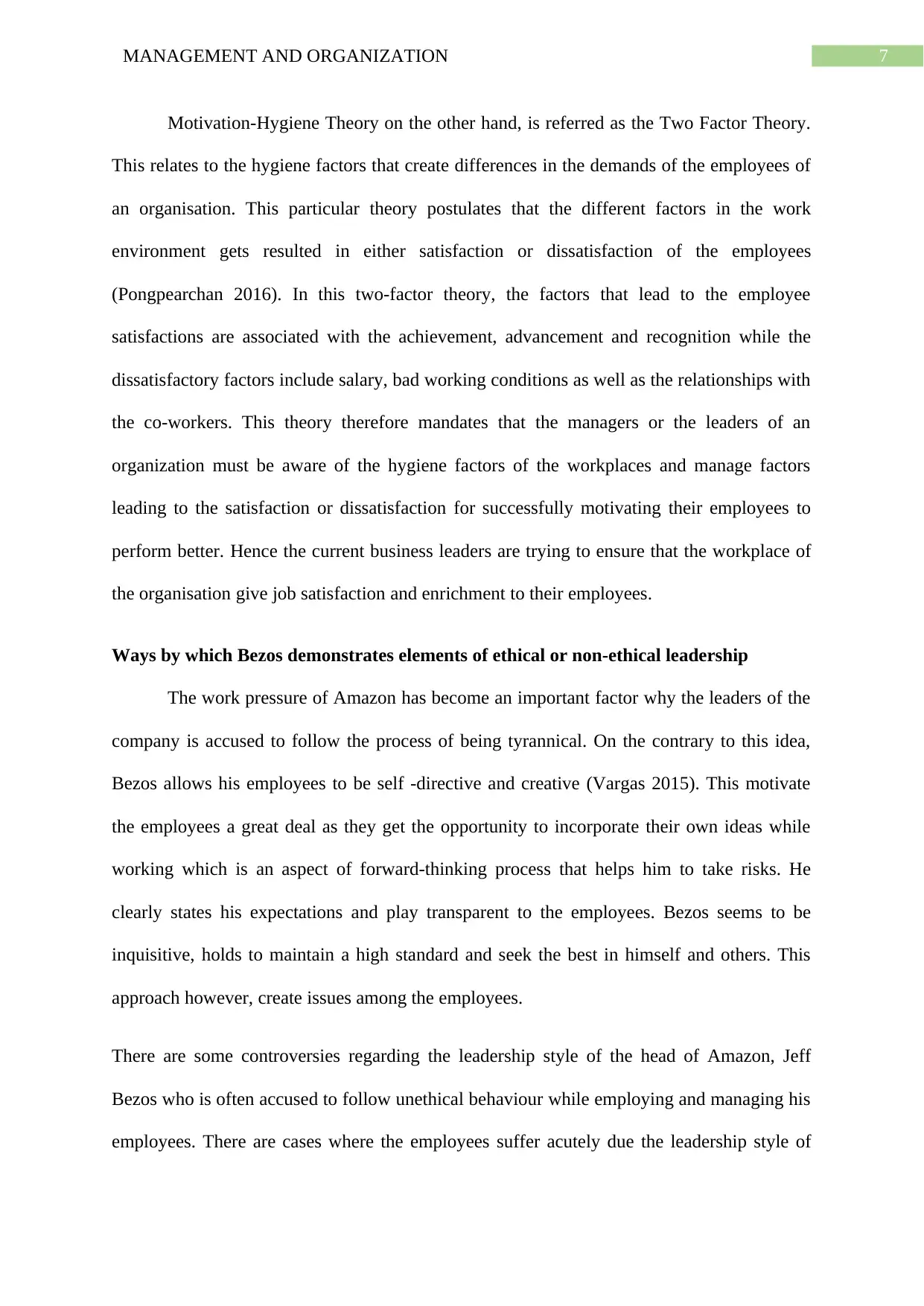
7MANAGEMENT AND ORGANIZATION
Motivation-Hygiene Theory on the other hand, is referred as the Two Factor Theory.
This relates to the hygiene factors that create differences in the demands of the employees of
an organisation. This particular theory postulates that the different factors in the work
environment gets resulted in either satisfaction or dissatisfaction of the employees
(Pongpearchan 2016). In this two-factor theory, the factors that lead to the employee
satisfactions are associated with the achievement, advancement and recognition while the
dissatisfactory factors include salary, bad working conditions as well as the relationships with
the co-workers. This theory therefore mandates that the managers or the leaders of an
organization must be aware of the hygiene factors of the workplaces and manage factors
leading to the satisfaction or dissatisfaction for successfully motivating their employees to
perform better. Hence the current business leaders are trying to ensure that the workplace of
the organisation give job satisfaction and enrichment to their employees.
Ways by which Bezos demonstrates elements of ethical or non-ethical leadership
The work pressure of Amazon has become an important factor why the leaders of the
company is accused to follow the process of being tyrannical. On the contrary to this idea,
Bezos allows his employees to be self -directive and creative (Vargas 2015). This motivate
the employees a great deal as they get the opportunity to incorporate their own ideas while
working which is an aspect of forward-thinking process that helps him to take risks. He
clearly states his expectations and play transparent to the employees. Bezos seems to be
inquisitive, holds to maintain a high standard and seek the best in himself and others. This
approach however, create issues among the employees.
There are some controversies regarding the leadership style of the head of Amazon, Jeff
Bezos who is often accused to follow unethical behaviour while employing and managing his
employees. There are cases where the employees suffer acutely due the leadership style of
Motivation-Hygiene Theory on the other hand, is referred as the Two Factor Theory.
This relates to the hygiene factors that create differences in the demands of the employees of
an organisation. This particular theory postulates that the different factors in the work
environment gets resulted in either satisfaction or dissatisfaction of the employees
(Pongpearchan 2016). In this two-factor theory, the factors that lead to the employee
satisfactions are associated with the achievement, advancement and recognition while the
dissatisfactory factors include salary, bad working conditions as well as the relationships with
the co-workers. This theory therefore mandates that the managers or the leaders of an
organization must be aware of the hygiene factors of the workplaces and manage factors
leading to the satisfaction or dissatisfaction for successfully motivating their employees to
perform better. Hence the current business leaders are trying to ensure that the workplace of
the organisation give job satisfaction and enrichment to their employees.
Ways by which Bezos demonstrates elements of ethical or non-ethical leadership
The work pressure of Amazon has become an important factor why the leaders of the
company is accused to follow the process of being tyrannical. On the contrary to this idea,
Bezos allows his employees to be self -directive and creative (Vargas 2015). This motivate
the employees a great deal as they get the opportunity to incorporate their own ideas while
working which is an aspect of forward-thinking process that helps him to take risks. He
clearly states his expectations and play transparent to the employees. Bezos seems to be
inquisitive, holds to maintain a high standard and seek the best in himself and others. This
approach however, create issues among the employees.
There are some controversies regarding the leadership style of the head of Amazon, Jeff
Bezos who is often accused to follow unethical behaviour while employing and managing his
employees. There are cases where the employees suffer acutely due the leadership style of
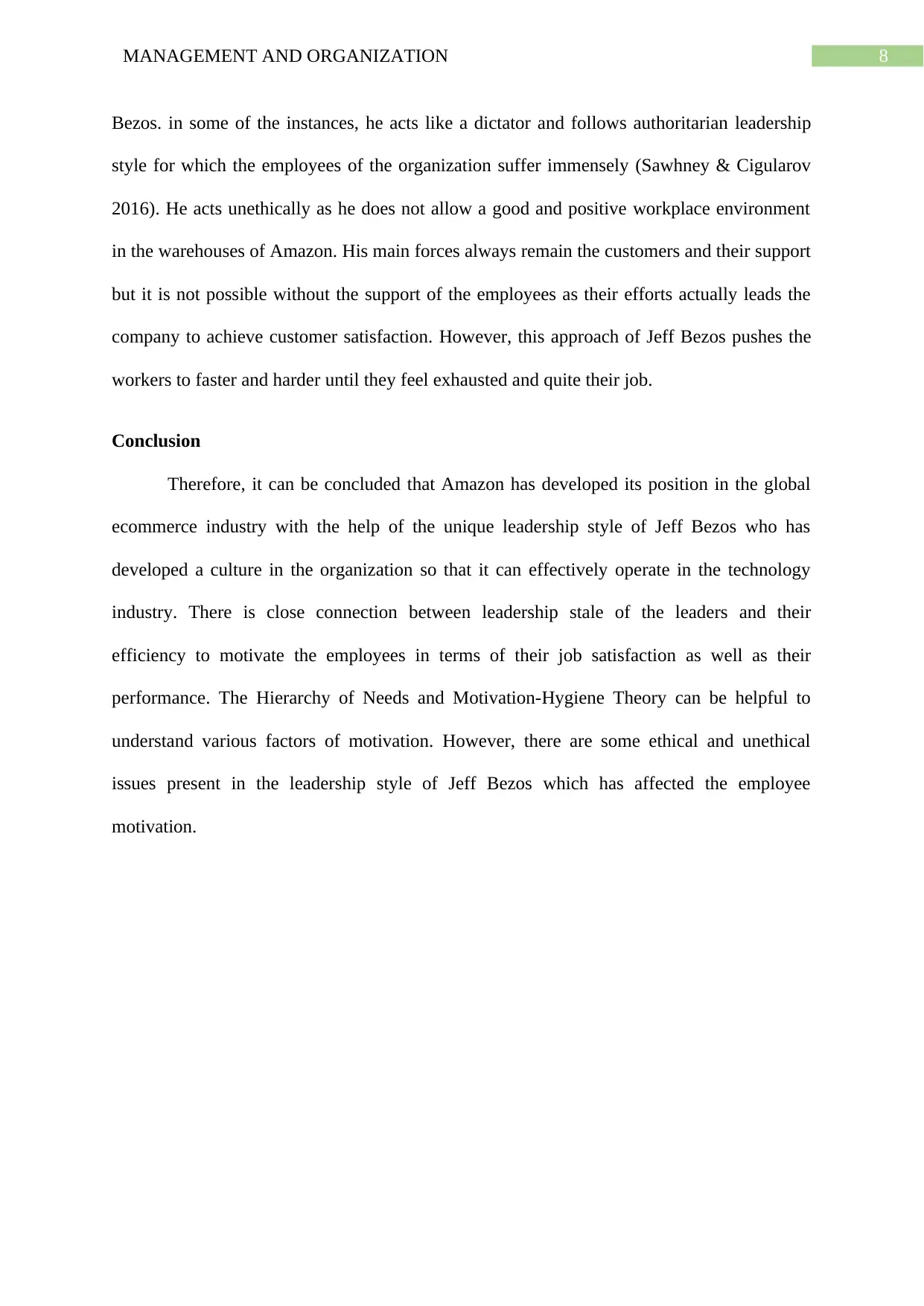
8MANAGEMENT AND ORGANIZATION
Bezos. in some of the instances, he acts like a dictator and follows authoritarian leadership
style for which the employees of the organization suffer immensely (Sawhney & Cigularov
2016). He acts unethically as he does not allow a good and positive workplace environment
in the warehouses of Amazon. His main forces always remain the customers and their support
but it is not possible without the support of the employees as their efforts actually leads the
company to achieve customer satisfaction. However, this approach of Jeff Bezos pushes the
workers to faster and harder until they feel exhausted and quite their job.
Conclusion
Therefore, it can be concluded that Amazon has developed its position in the global
ecommerce industry with the help of the unique leadership style of Jeff Bezos who has
developed a culture in the organization so that it can effectively operate in the technology
industry. There is close connection between leadership stale of the leaders and their
efficiency to motivate the employees in terms of their job satisfaction as well as their
performance. The Hierarchy of Needs and Motivation-Hygiene Theory can be helpful to
understand various factors of motivation. However, there are some ethical and unethical
issues present in the leadership style of Jeff Bezos which has affected the employee
motivation.
Bezos. in some of the instances, he acts like a dictator and follows authoritarian leadership
style for which the employees of the organization suffer immensely (Sawhney & Cigularov
2016). He acts unethically as he does not allow a good and positive workplace environment
in the warehouses of Amazon. His main forces always remain the customers and their support
but it is not possible without the support of the employees as their efforts actually leads the
company to achieve customer satisfaction. However, this approach of Jeff Bezos pushes the
workers to faster and harder until they feel exhausted and quite their job.
Conclusion
Therefore, it can be concluded that Amazon has developed its position in the global
ecommerce industry with the help of the unique leadership style of Jeff Bezos who has
developed a culture in the organization so that it can effectively operate in the technology
industry. There is close connection between leadership stale of the leaders and their
efficiency to motivate the employees in terms of their job satisfaction as well as their
performance. The Hierarchy of Needs and Motivation-Hygiene Theory can be helpful to
understand various factors of motivation. However, there are some ethical and unethical
issues present in the leadership style of Jeff Bezos which has affected the employee
motivation.
⊘ This is a preview!⊘
Do you want full access?
Subscribe today to unlock all pages.

Trusted by 1+ million students worldwide
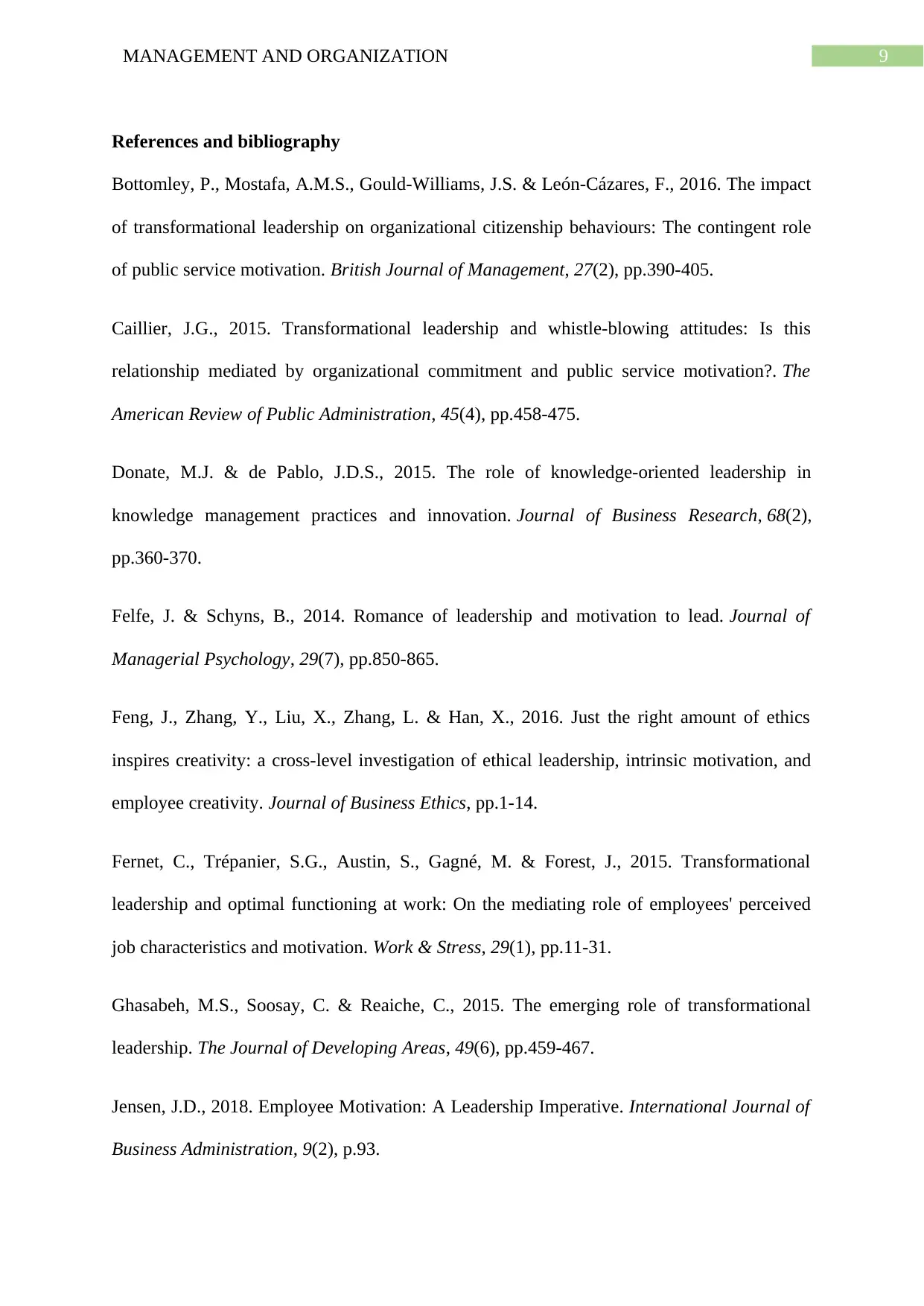
9MANAGEMENT AND ORGANIZATION
References and bibliography
Bottomley, P., Mostafa, A.M.S., Gould‐Williams, J.S. & León‐Cázares, F., 2016. The impact
of transformational leadership on organizational citizenship behaviours: The contingent role
of public service motivation. British Journal of Management, 27(2), pp.390-405.
Caillier, J.G., 2015. Transformational leadership and whistle-blowing attitudes: Is this
relationship mediated by organizational commitment and public service motivation?. The
American Review of Public Administration, 45(4), pp.458-475.
Donate, M.J. & de Pablo, J.D.S., 2015. The role of knowledge-oriented leadership in
knowledge management practices and innovation. Journal of Business Research, 68(2),
pp.360-370.
Felfe, J. & Schyns, B., 2014. Romance of leadership and motivation to lead. Journal of
Managerial Psychology, 29(7), pp.850-865.
Feng, J., Zhang, Y., Liu, X., Zhang, L. & Han, X., 2016. Just the right amount of ethics
inspires creativity: a cross-level investigation of ethical leadership, intrinsic motivation, and
employee creativity. Journal of Business Ethics, pp.1-14.
Fernet, C., Trépanier, S.G., Austin, S., Gagné, M. & Forest, J., 2015. Transformational
leadership and optimal functioning at work: On the mediating role of employees' perceived
job characteristics and motivation. Work & Stress, 29(1), pp.11-31.
Ghasabeh, M.S., Soosay, C. & Reaiche, C., 2015. The emerging role of transformational
leadership. The Journal of Developing Areas, 49(6), pp.459-467.
Jensen, J.D., 2018. Employee Motivation: A Leadership Imperative. International Journal of
Business Administration, 9(2), p.93.
References and bibliography
Bottomley, P., Mostafa, A.M.S., Gould‐Williams, J.S. & León‐Cázares, F., 2016. The impact
of transformational leadership on organizational citizenship behaviours: The contingent role
of public service motivation. British Journal of Management, 27(2), pp.390-405.
Caillier, J.G., 2015. Transformational leadership and whistle-blowing attitudes: Is this
relationship mediated by organizational commitment and public service motivation?. The
American Review of Public Administration, 45(4), pp.458-475.
Donate, M.J. & de Pablo, J.D.S., 2015. The role of knowledge-oriented leadership in
knowledge management practices and innovation. Journal of Business Research, 68(2),
pp.360-370.
Felfe, J. & Schyns, B., 2014. Romance of leadership and motivation to lead. Journal of
Managerial Psychology, 29(7), pp.850-865.
Feng, J., Zhang, Y., Liu, X., Zhang, L. & Han, X., 2016. Just the right amount of ethics
inspires creativity: a cross-level investigation of ethical leadership, intrinsic motivation, and
employee creativity. Journal of Business Ethics, pp.1-14.
Fernet, C., Trépanier, S.G., Austin, S., Gagné, M. & Forest, J., 2015. Transformational
leadership and optimal functioning at work: On the mediating role of employees' perceived
job characteristics and motivation. Work & Stress, 29(1), pp.11-31.
Ghasabeh, M.S., Soosay, C. & Reaiche, C., 2015. The emerging role of transformational
leadership. The Journal of Developing Areas, 49(6), pp.459-467.
Jensen, J.D., 2018. Employee Motivation: A Leadership Imperative. International Journal of
Business Administration, 9(2), p.93.
Paraphrase This Document
Need a fresh take? Get an instant paraphrase of this document with our AI Paraphraser
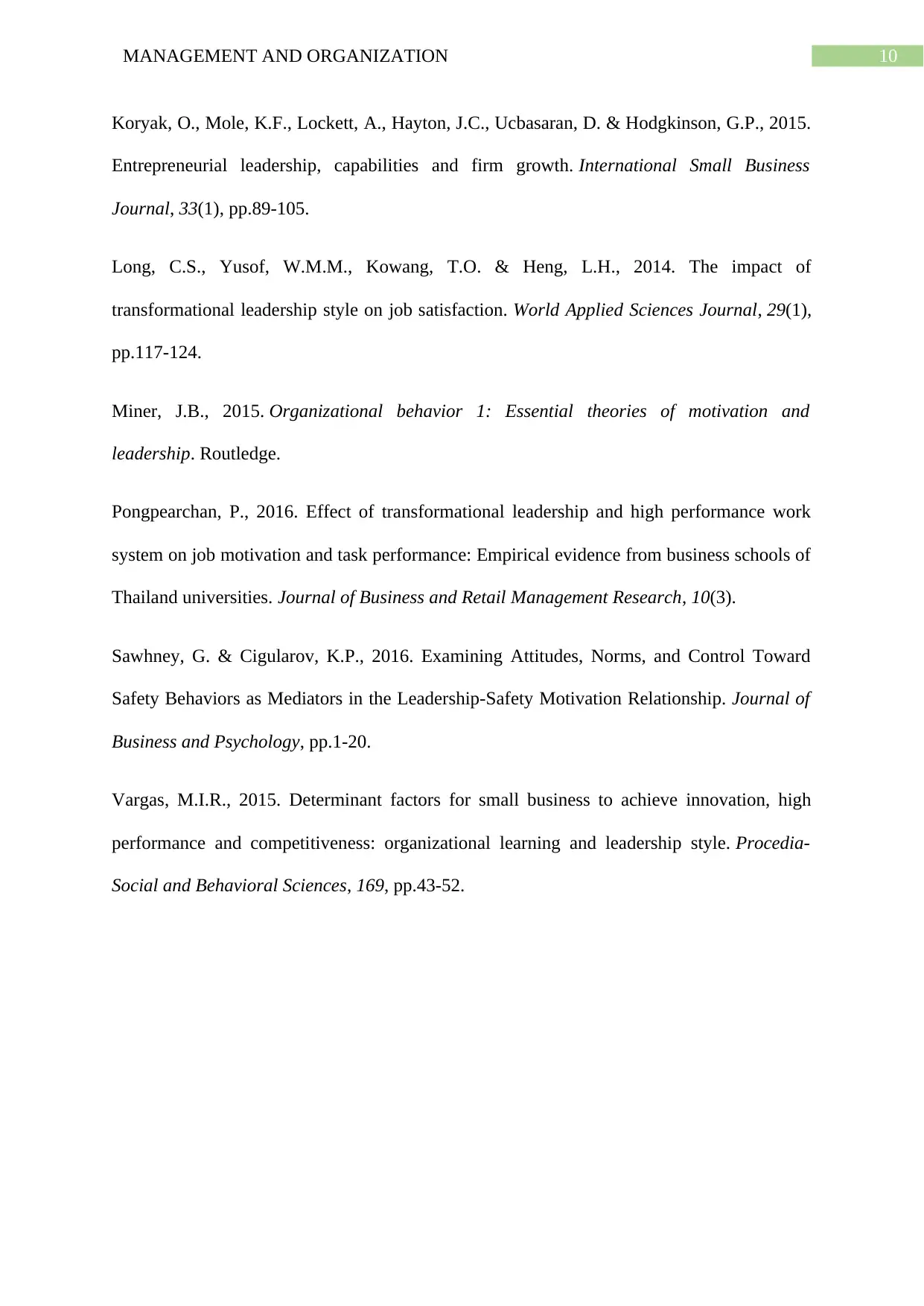
10MANAGEMENT AND ORGANIZATION
Koryak, O., Mole, K.F., Lockett, A., Hayton, J.C., Ucbasaran, D. & Hodgkinson, G.P., 2015.
Entrepreneurial leadership, capabilities and firm growth. International Small Business
Journal, 33(1), pp.89-105.
Long, C.S., Yusof, W.M.M., Kowang, T.O. & Heng, L.H., 2014. The impact of
transformational leadership style on job satisfaction. World Applied Sciences Journal, 29(1),
pp.117-124.
Miner, J.B., 2015. Organizational behavior 1: Essential theories of motivation and
leadership. Routledge.
Pongpearchan, P., 2016. Effect of transformational leadership and high performance work
system on job motivation and task performance: Empirical evidence from business schools of
Thailand universities. Journal of Business and Retail Management Research, 10(3).
Sawhney, G. & Cigularov, K.P., 2016. Examining Attitudes, Norms, and Control Toward
Safety Behaviors as Mediators in the Leadership-Safety Motivation Relationship. Journal of
Business and Psychology, pp.1-20.
Vargas, M.I.R., 2015. Determinant factors for small business to achieve innovation, high
performance and competitiveness: organizational learning and leadership style. Procedia-
Social and Behavioral Sciences, 169, pp.43-52.
Koryak, O., Mole, K.F., Lockett, A., Hayton, J.C., Ucbasaran, D. & Hodgkinson, G.P., 2015.
Entrepreneurial leadership, capabilities and firm growth. International Small Business
Journal, 33(1), pp.89-105.
Long, C.S., Yusof, W.M.M., Kowang, T.O. & Heng, L.H., 2014. The impact of
transformational leadership style on job satisfaction. World Applied Sciences Journal, 29(1),
pp.117-124.
Miner, J.B., 2015. Organizational behavior 1: Essential theories of motivation and
leadership. Routledge.
Pongpearchan, P., 2016. Effect of transformational leadership and high performance work
system on job motivation and task performance: Empirical evidence from business schools of
Thailand universities. Journal of Business and Retail Management Research, 10(3).
Sawhney, G. & Cigularov, K.P., 2016. Examining Attitudes, Norms, and Control Toward
Safety Behaviors as Mediators in the Leadership-Safety Motivation Relationship. Journal of
Business and Psychology, pp.1-20.
Vargas, M.I.R., 2015. Determinant factors for small business to achieve innovation, high
performance and competitiveness: organizational learning and leadership style. Procedia-
Social and Behavioral Sciences, 169, pp.43-52.
1 out of 11
Related Documents
Your All-in-One AI-Powered Toolkit for Academic Success.
+13062052269
info@desklib.com
Available 24*7 on WhatsApp / Email
![[object Object]](/_next/static/media/star-bottom.7253800d.svg)
Unlock your academic potential
Copyright © 2020–2025 A2Z Services. All Rights Reserved. Developed and managed by ZUCOL.




